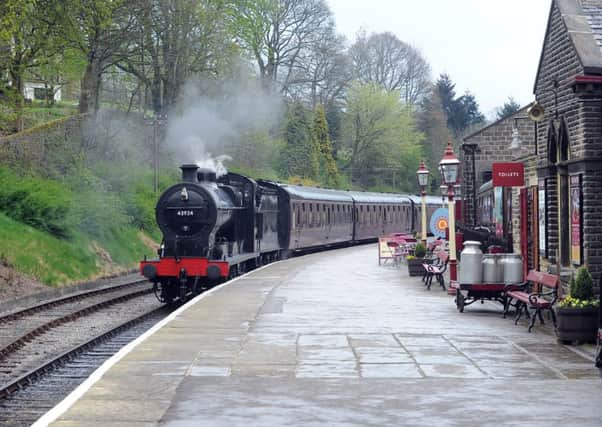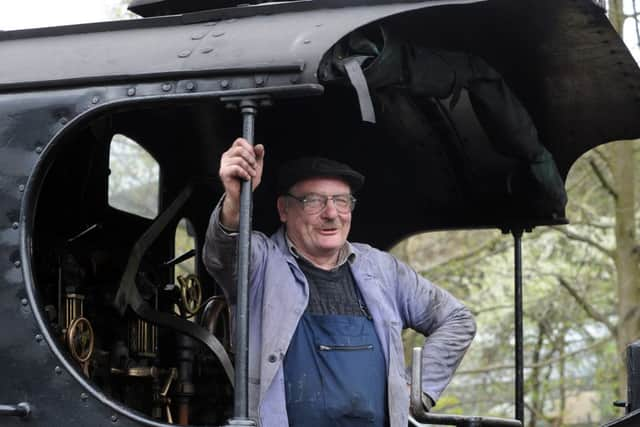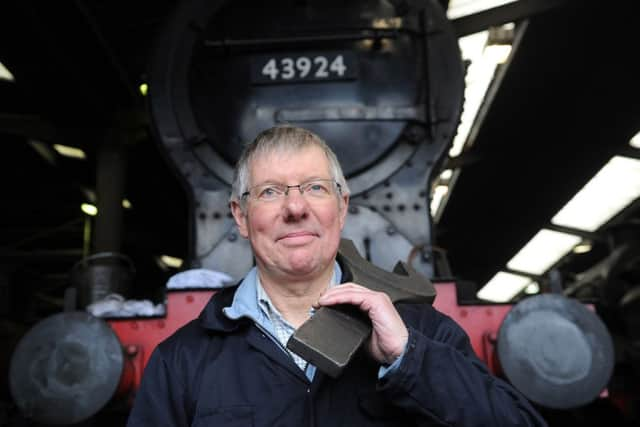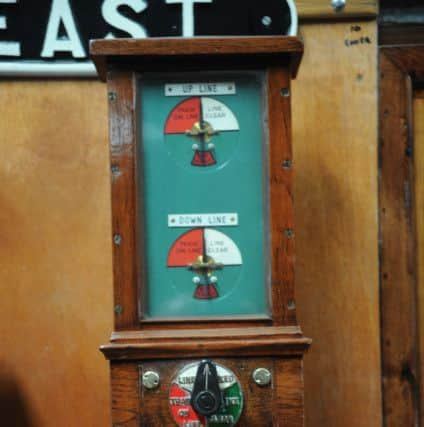New arrivals stepping up to the footplate


IT’S A tough old job keeping this vintage locomotive’s steam up. By the end of the day, fireman Tom Kay will be hot and grimy after tending it since 5am and shovelling three tons of coal into its roaring firebox.
But that’s fine by him, because Tom has bags of energy and is fascinated by this clanking, hissing, smelly 94-year-old engine that belongs to an era long before he was born. So fascinated that he’s determined to one day be doing the driving while somebody else does the shovelling.
Advertisement
Hide AdAdvertisement
Hide AdTom, from Bingley, is only 20 and the Keighley and Worth Valley Railway’s youngest fireman, having just passed the stringent exams that the role requires. He’s studying mechanical engineering at Huddersfield University, and the steam locomotive that depends on his hard graft to make its stately way through Brontë country to the waves and smiles of passers-by is a hands-on example of what his chosen subject achieved in a bygone age.


He’s one of an increasing number of young people on the heritage line famous the world over as the home of The Railway Children drawn to spend their free time helping to keep steam trains alive, getting on for 50 years after they disappeared from everyday use.
It’s a fact of life that there is a lot of grey hair around on heritage railways. Their backbone is older volunteers who grew up with steam, or even worked with it on British Rail. But the preserved lines need younger people to keep them going into the future, and here at the KWVR, they’re arriving.
Tom was a real-life railway child, growing up with the line. “My granddad has been involved since the railway started, and I’ve been coming with him since I was a baby,” he said.
Advertisement
Hide AdAdvertisement
Hide Ad“I started off in the shed cleaning engines and doing repairs, and gradually worked my way up to a trainee fireman and passed my exams.


“It must just be in my blood because I’ve been coming since I was tiny. I like the power and the noise and the whole regalia that goes with it. It’s awesome.”
Youth and experience are in perfect harmony on the footplate, because Tom’s companion is driver Robin Higgins, 70, from Barnoldswick. The railway claimed him young as well, and he understands Tom’s fascination. He was on the last British Rail service to run through the valley before the line was closed in 1962, and back for its rebirth six years later.
“You have to get them early, before they get interested in computers and girls,” he said. “It’s lovely to see young people start on here.”
Advertisement
Hide AdAdvertisement
Hide AdThere are plenty of them. In the guard’s van of Robin and Tom’s train, waving the green flag to signal it away is Joe Cooper, 18, from Denholme, who’s finishing his final year in sixth form. “I have a few friends who were here, so I came down to have a look,” he said.


“It’s a bit like acting – you’re portraying a part and recreating how it used to be on the railways. Sometimes, I think the railway’s more for us than the passengers.”
On the platform, working on the railway’s bus service that takes passengers for a run through the moors of Wuthering Heights is IT student Sam Bates, 18, from Cleckheaton, who said: “I’ve always visited here since I was little, and I thought: ‘I can do that’.”
And along the line at Keighley the stationmaster is Andy Brown, 20, from Yeadon, who like the rest was captivated by the romance surrounding steam. He said: “It’s just the sorts of smells, sounds and being around the aura of them, and I like the public front side of things. A lot of younger people find it really interesting, and I can talk to the youngsters at their own level.”
Advertisement
Hide AdAdvertisement
Hide AdThe young volunteers get more out their time here than just enjoyment. In a lot of cases, they are going on to careers on “the big railway”, as the heritage lines call the mainline network, because of what they have learned.
But then youth is intertwined with the history of the KWVR since the line reopened in 1968. The volunteers who rolled up their sleeves and spent six years digging, clearing and restoring it to running order after it fell victim to the Beeching cuts were predominantly young.
Now there are about 450 volunteers, running the line 200 days a year. Without them, it simply could not operate.
One of the longest-standing is Roger France, 60, who was in right at the beginning, aged only 15. “My mother’s side of the family were railwaymen, so I grew up with railways and steam engines, and then in ’68 when this railway started, it was a natural progression. But I’ve never not been next to steam engines. It’s part of my life.”
Advertisement
Hide AdAdvertisement
Hide AdRoger’s passion led to membership of a group which owns two locomotives. It’s an expensive business. The restoration of the first, in 1972, cost £10,000. The backdrop was that his wage at the time was £1,000 a year and he was buying a house for £9,000.
Now, each locomotive has to be completely stripped down and overhauled every 10 years, at a cost of up to £300,000.
“My life is measured in those 10-year chunks,” said Roger. “When you can drive your own engine, life doesn’t get any better. But when it’s a Monday morning, and you’re trying to repair it to get it ready for the weekend, and you’re in a pit underneath it, the glamour does go out of it a bit.”
Not for the 100,000-plus visitors a year, though, many of whom hang out of the carriage windows, braving grit in the eyes, to drink in the sounds and smells of the steam engine as it takes them from Keighley to Oxenhope.
Advertisement
Hide AdAdvertisement
Hide AdIt’s all part of the glamour and romance of a more elegant age that draws them in. Stepping onto the platform takes them into a world dating from 1867, when the line opened to carry coal to the mills of the valley, and it’s the atmosphere that captivates them as much as the steam locomotives.
That atmosphere is for real. The KWVR’s stations are gaslit, thanks to the second biggest gas lighting installation outside Buckingham Palace. Indeed, electricity only made it to Oakworth station a couple of years ago.
Roger said: “When we did a survey of what people noticed, one of the first things was the staff in uniforms. We’ve got gaslit stations, so it’s the period atmosphere. Whenever we run historic carriages, everybody gravitates to those.
“We’ve got a complete five-mile long branch line just how it was. It’s an original railway doing the original job, with the line serving the villages in the valley. It was built to serve woollen mills and now it serves the tourist industry.”
Advertisement
Hide AdAdvertisement
Hide AdThe KWVR was in the vanguard of the heritage railway movement, and has pioneered new ways of bringing in visitors and income. Santa Specials started here, and the line has introduced real ale onto trains, winning Camra awards, thanks to an ingenious method of decanting beer into old tea urns that are then put on the trains.
“We’re always trying to think of things to keep it fresh,” said Roger. “We’re lucky here to have the Brontë connection. We rely on day trippers, so we tend to run all year round.
“We manage to operate just with volunteers, which is something we’re very proud of. We consider ourselves a community railway, and that’s something we’re also proud of. We’ve built this up from nothing, and we’re sustainable because we’ve been doing it ourselves for 40 years.”
These days, Roger looks after the frequent requests from production companies to film period dramas on the line, which is a useful source of income. The BBC’s dramatisation of the Great Train Robbery was done here, as were scenes for Peaky Blinders and the forthcoming new version of Vera Brittain’s Testament of Youth.
Advertisement
Hide AdAdvertisement
Hide AdBut it’s the most beloved of all British family films that has done the KWVR most favours of all.
“The Railway Children is our brand,” said Roger. “When that film came out in 1970, immediately our passenger figures went through the roof. People come to see where the film’s made.
“When it was made into a play, first in York, then at the old Eurostar terminal at Waterloo and later in Canada, there was a noticeable effect then. It shows how fresh it is. The film’s on every Christmas, and it’s as fresh now as it was then.”
The Keighley and Worth Valley Railway can be found at www.kwvr.co.uk